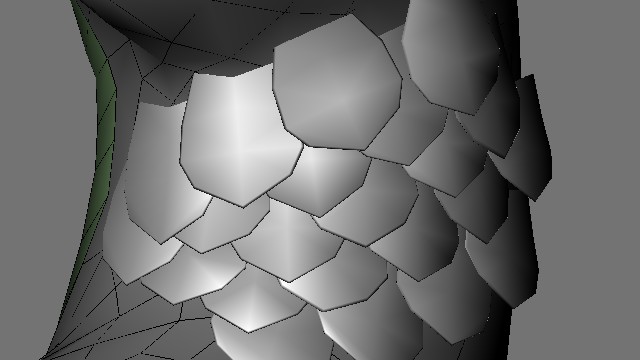This is an old project I’ve been working on lately. The idea is to create true geometry non-deforming animated scales. And a dragon to place them on, of course.
Not much to show now other than the dragon:

This is an old project I’ve been working on lately. The idea is to create true geometry non-deforming animated scales. And a dragon to place them on, of course.
Not much to show now other than the dragon:

You trashed the old topic? Or have you started over?
@Oijin: I trashed the old topic in order to comply with the new trend of having a view count of post+1.
Awful but mandatory video:
Test video on Youtube
A description on how the setup works
After trying different ways of achieving true scales I’ve ended up with a vertex-parented, paper-thin sensor-scale and a python script to rotate the scales. The setup consists of two special meshes with the same weight as the dragon mesh (created a script for the task) an sensors scales. One of these is the vertex parent mesh. The other one is a sensor mesh for the scale rotation script.

The blue mesh is the vertex parent mesh in image above. Each control scale is parented to a triangle in the vertex parent mesh. As a result the scale follow the deformation of the dragon, however this alone would not avoid intersections. To prevent the scale from intersecting a python script rotates all the control scales to rest a predefined distance from the surface of the scale underneath it.
A scale sensor (gray) is a paper thin equivalent of the scale placed there. Its purpose is to simplify the python script by making it easy to detect whether a scale is above or underneath an other scale. This also reduce the time it takes to run the script since to scale sensor has less polygons to consider.
The yellow mesh is the sensor mesh. This mesh describes the skin surface for the python script. There’s a vertex group for every scale, with the same name as the scale it refers to. Each vertex group contains the verts underneath the scale. Again this improves performance by greatly reducing the number of polygons to calculate the distance to.
Note: The senor mesh was broken in the video. A better video is in progress.
I like this… I always wondered how to do this kinda stuff . Will keep a watch for updates.
I always wondered how to do this kinda stuff . Will keep a watch for updates. 
I would still go for a proper texture setup. Unless you plan heavy close-ups. You hardly ever see the difference on a distance and you get the entire sensor stuff for free. Otherwise that’s like shooting pigeons with canon balls. Otherwise, ever tried physics? I think the bullet integration in blender should have the spring constraints working now. You would have to parent each scale with a hinge constraint applying a spring factor to it so it is pulled back to rest pose. I don’t know though how well the integration of bullet is in blender.
@Odjin: Before mention anything let me recite the goal of this project
The idea is to create true geometry non-deforming animated scales
Whether this is shooting pigeons with canon balls is my problem.
If this project turns out to be a complete flop, I’ll learn my lesson and start listening to the community. For now I’ll continue on creating non-deforming scales. In any outcome I’ve learn a lot of python programming, the (soon obsolete) Blender API, vector arithmetic, and riging.
As for using the physics engine. Never thought of that, unfortunately I already have a working setup with some 800 lines of python code to support it.
@jayrajkharvadi: I appreciate your support ![]()
compare this

with this

Long time no see. Been away from blender the entire summer.
Continuing from where i left, this is where I am now:Video on Youtube
Very very long time no see, actually about time to finish this. I’ve moved to 2.5 with the scale rig, only need some more scripting and it will be running. The model of the body is almost complete, the rig is next, and then the scale rig.

That’s an amazing dragon! What do you plan to do with the rig after you’re done with it? I’m sure you might get a bit of money if you wanted to sell it, I’m sure you would make good money.
@Mataby: I wont sell it, ever. I do however have plans in to making a paper model out of it and put it on my desk.